Download Biological Diversity - New York State Museum
Download Biological Diversity - New York State Museum
Download Biological Diversity - New York State Museum
Create successful ePaper yourself
Turn your PDF publications into a flip-book with our unique Google optimized e-Paper software.
some degree of potency. A much higher percentage yield pharmaceuticals and other<br />
natural products of potential use as well as basic scientific information. If we dismiss<br />
beardtongues and louseworts, we may be doing ourselves a considerable disservice.<br />
Simple prudence dictates that no species, however humble, should ever be allowed<br />
to go extinct if it is within the power of humanity to save it. Take another—even<br />
repugnant—example, the leech. We would certainly be better off without these<br />
miserable bloodsuckers, right? Wrong. The medicinal leech of Europe has proved to<br />
be of great value to modern medicine. To prevent the blood of its victims from<br />
clotting, it secretes a powerful anticoagulant called hirudin. This substance is used to<br />
treat contusions, thrombosis, hemorrhoids and other conditions in which clotting<br />
blood can be painful or dangerous. Thousands of lives are saved annually by hirudin.<br />
The leech uses a second substance, the enzyme hyaluronidase, to disperse cells and<br />
hasten the penetration of hirudin. Surgeons adapt this material in the same way to<br />
spread injected drugs and anesthetics. Leeches also contain antibiotics and substances<br />
that enlarge the diameter of blood vessels, which might someday lead to a cure<br />
for migraine headaches. Medicinal leeches are now the basis of a $4 million annual<br />
business. They are so much in demand that the European species is threatened by<br />
overcollecting in its natural habitat.<br />
With the aid of other specialists (my own special group is ants), I have estimated<br />
the total number of kinds of plants, animals, and microorganisms known to science<br />
to be about 1.4 million. By “known to science” we mean characterized anatomically<br />
and given a scientific name, such as Canis familiaris for the domestic dog, Hirudo<br />
medicinalis for the European medicinal leech, and Homo sapiens for humans. But<br />
the actual number of kinds is estimated to fall somewhere between 10 million and<br />
80 million, depending on the statistical method used and the degree of conservativeness<br />
on the part of the scientist making the estimate. The truth is that we don’t<br />
know even to the nearest order of magnitude the amount of diversity. In other words,<br />
we cannot say whether the figure is closer to 1 million, 10 million or 100 million.<br />
When scientists fail to make a measurement to the nearest order of magnitude,<br />
it is fair to surmise that the subject is still poorly known. The truth is that life on<br />
planet earth has only begun to be explored. Every time I go to a rainforest site in<br />
Central or South America, I find new species of ants within several hours of searching.<br />
B i o l o g i c a l<br />
3 D i v e r s i t y
















